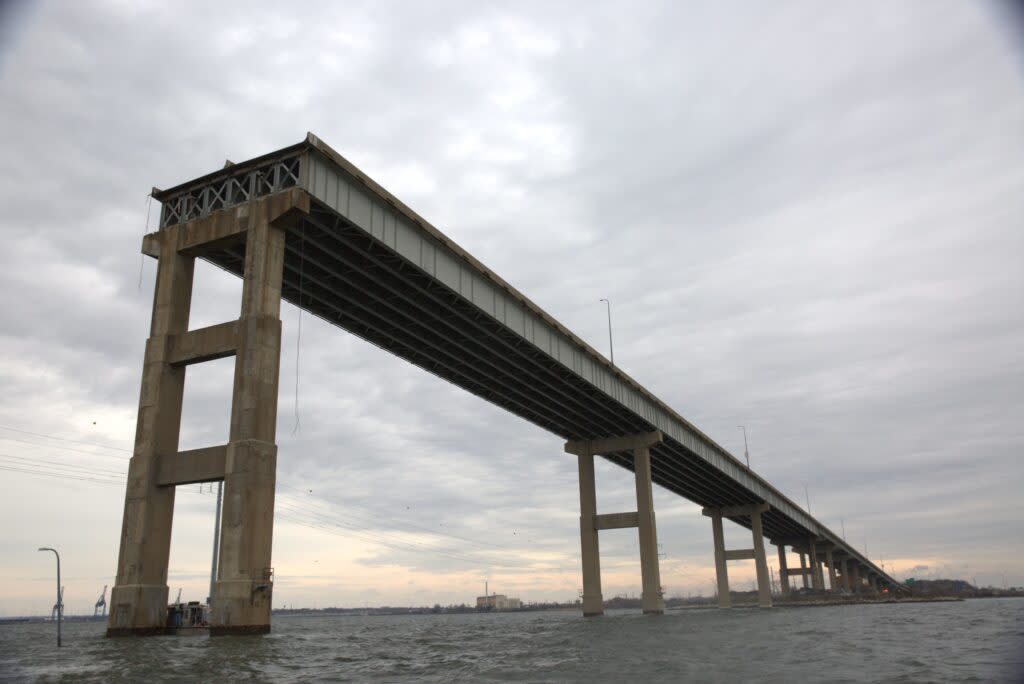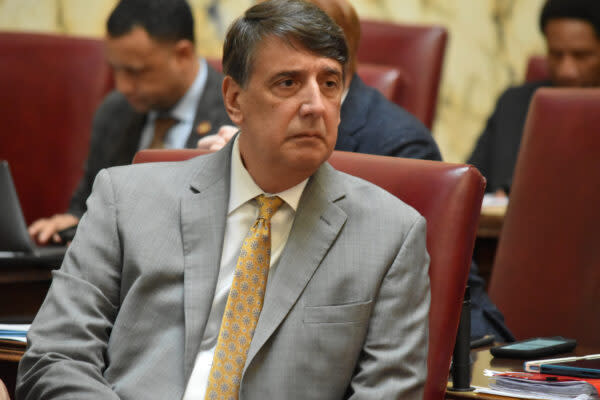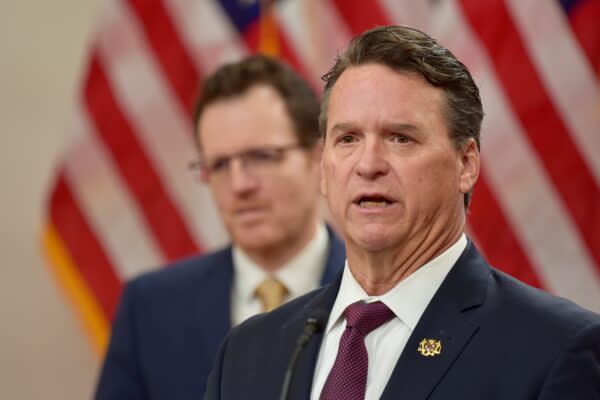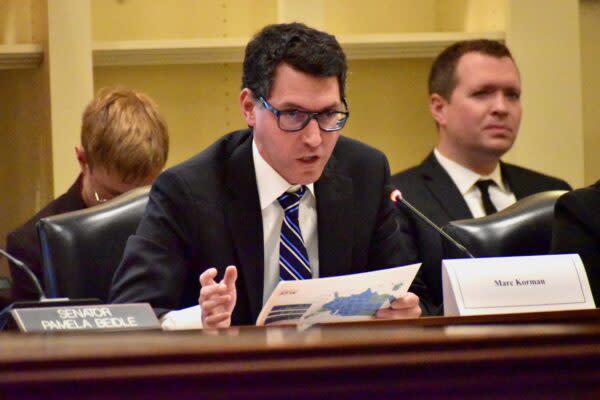Shipping channel set to reopen as plans to rebuild Key Bridge press ahead

Remnants of the Francis Scott Key Bridge. Photo from the Maryland Department of Transportation Flickr account.
Maryland officials are moving ahead with an aggressive effort to replace the Francis Scott Key Bridge, while questions about how much it will cost and how to pay for the potentially multibillion-dollar structure remain unresolved.
Those questions have not slowed work on the bridge, which collapsed into the Patapsco River when it was hit by a massive cargo ship, killing six, sending hundreds of tons of debris into the river and shutting down the channel into the Port of Baltimore.
After months of work, officials said they expect to have the full 700-foot-wide and 50-foot-deep Fort McHenry Channel reopened to shipping by Monday, if not sooner.
Next steps include rebuilding the bridge, a vital commuting and shipping route for Baltimore. State officials have set an aggressive timeline for rebuilding the bridge, issuing a request in late May for proposals to build a bridge that exceeds the 75-year initial life expectancy and has the fewest supports possible in the Patapsco, to reduce the potential of future ship collisions.
Those bids are due by the end of this month.
But questions remain about the cost of a new bridge built to modern federal standards, and on how a federal takeover of the Key Bridge, a Maryland toll facility, might affect the state’s ability to collect tolls that go into the state’s transportation funds.
Senate Budget and Taxation Chair Guy Guzzone (D-Howard) said that while it’s important to review how federal aid could affect tolling and bond issued by the Maryland Transportation Authority, that’s not a priority right now.

“I think that regardless of what restrictions there may be or may not be, the bottom line is we need the help of the federal government,” Guzzone said. He said his committee has “not had time to get into the depths” of the toll question.
“I’m sure we will. I’m sure the committee will at some point,” he said.
In March, the Dali, a 948-foot container ship, collided with support structure on the 47-year-old bridge over the Patapsco, causing the center section to collapse. Six workers on a road crew that was working on the bridge died in the accident.
The bridge is a critical transportation link, connecting southeastern Baltimore City with Anne Arundel and southwestern Baltimore Counties and giving trucks a way around the Harbor and Fort McHenry tunnels, which prohibit hazardous materials.
More than 30,000 vehicles use the bridge daily. The facility collected $56 million in tolls in fiscal 2023.
Related Stories
Congressional panel debates who should foot the bill for rebuilding Key Bridge
Board approves hiring outside attorneys for Key Bridge litigation
How the collapse of the Francis Scott Key Bridge highlights food insecurity in Maryland
Bill mandating feds pay entire cost of Key Bridge rebuild unveiled by Marylanders
Maryland congressional delegation to launch bipartisan push for funds to rebuild bridge
Federal rebuild of Baltimore bridge ‘will not be quick or easy or cheap,’ Buttigieg says
Biden pledges federal dollars for ‘entire cost’ to rebuild collapsed Baltimore bridge
Key Bridge collapses after container ship slams into it, six workers presumed dead
State lawmakers scrambled in the waning days of the legislative session to pass aid for workers and businesses affected by even a partial port closure. Within hours of the collapse, President Joe Biden was promising enough federal aid to pay the full cost of a replacement. But that would require congressional approval, which has not yet come.
“Quite frankly, my understanding is the last time that a bridge went down, Congress acted fairly quickly,” Guzzone said. “Again, confident that they will but the sooner the better.”
Within days of the 2007 collapse of the Interstate 35 bridge in Minnesota, Congress had authorized nearly all of the $300 million to rebuild it.
“This is a little bit unique in that, at least to my knowledge, it is the first grandfathered toll facility that has had this kind of manmade disaster,” said John Porcari, who served as state transportation secretary under Govs. Parris Glendening and Martin O’Malley. “So, it is a little bit unique.”
The transportation authority said in a statement that the state would “leverage insurance proceeds and available state and federal resources to keep the project advancing.” The state has hired an outside team of lawyers to assist with bridge-related litigation and insurance claims.
“The MDTA was planning for roughly $15-$20 million of its capital program funds if needed to cover initial design and engineering of the new bridge,” the agency’s statement said. “However, the MDTA will be receiving its $350 million in property damage insurance proceeds in the next 45 days, so these funds would be available for initial design and engineering.”
The Key Bridge, opened in 1977, was not originally part of the federal interstate system. It is also a toll facility — part of a system of eight toll bridges, roads, and tunnels — operated by the Maryland Transportation Authority.
After the collapse, the Federal Highway Administration and the state moved to add the Key Bridge to the federal interstate system. Without the redesignation, the federal government and state could split the costs 80-20, but the change would allow the federal government to pay more of the tab.
“With this change, the formula will take care of 90%,” said House Environment and Transportation Chair Marc Korman (D-Montgomery). “I don’t think it changes anything. I think the intention is still that it will be part of the toll authority.”
State transportation officials set an aggressive timeline for rebuilding the bridge.
Bid proposals must be submitted to the state by the end of the month. Officials hope to choose a contractor in July. The hope is to complete the new span by 2028.
Preliminary back-of-the-envelope estimates place the cost of replacing the structure between $1.7 and $1.9 billion.
“It’ll be a four-year construction and that is that critical piece where Maryland will have the certainty that that federal funding will be available so that they can move forward with their procurement,” Federal Highway Administrator Shailen Bhatt to a House panel in Washington last month when asked about the importance of 100% federal funding for a replacement bridge.

Some in Congress voiced concerns about federal dollars going to replace a toll facility and whether the aid should end tolls at the facility or, if tolling continued, if that money should be used to repay the federal government.
Porcari said the use of federal emergency funds “should not upset or preclude the existing toll arrangement on the bridge and then the existing use of tolls on the bridge. Now, some clarification may be required down the road. That’s something that the Maryland delegation will focus on if they need to.”
Not everyone is so sure.
Senate Minority Leader Stephen S. Hershey Jr. (R-Upper Shore) expressed concern that full federal funding could result in even higher tolls. The transportation authority has already announced it will need to increase tolls by 2028.
“Are there any potential unintended consequences for this?” asked Hershey. “All of a sudden, by accepting money from the federal government, are we no longer able to toll this (the Key Bridge) and if that’s the case, why would I go through one of the tunnels for $6 or $8 if I could go across the Key Bridge for zero dollars?”
Funds collected at all the state’s toll facilities are pooled and used to cover bonds issued for maintenance and upgrades at individual facilities.
State transportation officials, speaking during a meeting of the transportation authority board, said the agency has enough revenue currently to make existing debt payments even with the absence of Key Bridge tolls.
Moving the bridge into the federal interstate system may also run afoul of existing federal policy regarding tolls on federal interstates.
“I do think there is kind of a potential tolling issue,” Korman said. “I’m not sure it’s related to this reclassification, but just to the feds paying in general, because the sort of basic federal policy is that tolls are to pay for what’s being tolled. If you have surplus of that, you can sort of get federal highway permission to use it for other purposes.”

Typically, states are only allowed to add tolls when adding extra lanes that expand capacity, such as toll lanes on I-95 between Baltimore City and Harford County or those once proposed to expand the Capital Beltway.
“I think there’s some discussion of like, how does that work here where 100% is going to be paid for by the feds?” Korman asked. “I think the answer is well, we still have to maintain it. Bridge building it’s great, but you have to do a lot of things to maintain it. That’s a sort of a discussion that I’ve heard struggled about a little bit is — what’s going to happen to sort of its tolling status because of that issue. Not the reclassification, but you know, if the feds pay for 100%.”
In its statement Friday, the transportation authority said it expects to continue operating the new bridge as a toll facility if the federal government pays for the full replacement.
“To ensure that commuters and commerce move efficiently across all three Baltimore Harbor crossings and within the local roadway network, the Key Bridge must remain part of Maryland’s tolled transportation system,” the statement said. “Toll revenues would continue to support bridge operations and maintenance as well as capital expenditures related to the other 9 miles of the MDTA owned portion of I-695. … including the bridges over Bear Creek and the Curtis Creek Draw Bridge.”
In the end, the federal government will decide all the open questions, Porcari said.
“The federal government can do what it wants, it can pay for a toll facility,” he said.
The post Shipping channel set to reopen as plans to rebuild Key Bridge press ahead appeared first on Maryland Matters.

